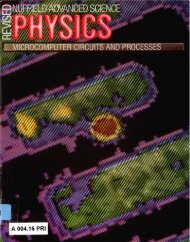RISC vs. CISC
RISC vs. CISC
RISC vs. CISC
Create successful ePaper yourself
Turn your PDF publications into a flip-book with our unique Google optimized e-Paper software.
CECS 440 Computer Architecture © 1999 R. W. Allison<br />
hardwired control unit. This control unit takes the instruction as its input and activates some circuitry that<br />
carries out the task. For instance, if the machine fetches a floating-point ADD and feeds it to the control unit,<br />
there’s a circuit somewhere in there that kicks in and directs the execution units to make sure that all of the<br />
shifting, adding, and normalization gets done. Direct execution is actually pretty much what you’d expect to go<br />
on inside a computer if you didn’t know about microcoding.<br />
The main advantage of direct execution is that it’s fast. There’s no extra abstraction or translation going on; the<br />
machine is just decoding and executing the instructions right in hardware. The problem with it is that it can take<br />
up quite a bit of space. Think about it. If every instruction has to have some circuitry that executes it, then the<br />
more instructions you have, the more space the control unit will take up. This problem is compounded if some<br />
of the instructions are big and complex, and take a lot of work to execute. So directly executing instructions for<br />
a <strong>CISC</strong> machine just wasn’t feasible with the limited transistor resources of the day.<br />
Enter microprogramming. With microprogramming, it’s almost like there’s a mini-CPU on the CPU. The<br />
control unit is a microcode engine that executes microcode instructions. The CPU designer uses these<br />
microinstructions to write microprograms, which are stored in a special control memory. When a normal<br />
program instruction is fetched from memory and fed into the microcode engine, the microcode engine executes<br />
the proper microcode subroutine. This subroutine tells the various functional units what to do and how to do it.<br />
As you can probably guess, in the beginning microcode was a pretty slow way to do things. The ROM used for<br />
control memory was about 10 times faster than magnetic core-based main memory, so the microcode engine<br />
could stay far enough ahead to offer decent performance [7]. As microcode technology evolved, however, it got<br />
faster and faster. (The microcode engines on current CPUs are about 95% as fast as direct execution [10].) Since<br />
microcode technology was getting better and better, it made more and more sense to just move functionality<br />
from (slower and more expensive) software to (faster and cheaper) hardware. So ISA instruction counts grew,<br />
and program instruction counts shrank.<br />
As microprograms got bigger and bigger to accommodate the growing instructions sets, however, some serious<br />
problems started to emerge. To keep performance up, microcode had to be highly optimized with no<br />
inefficiencies, and it had to be extremely compact in order to keep memory costs down. And since microcode<br />
programs were so large now, it became much harder to test and debug the code. As a result, the microcode that<br />
shipped with machines was often buggy and had to be patched numerous times out in the field. It was the<br />
difficulties involved with using microcode for control that spurred Patterson and others began to question<br />
whether implementing all of these complex, elaborate instructions in microcode was really the best use of<br />
limited transistor resources [11].<br />
III. The <strong>RISC</strong> solution<br />
For reasons we won’t get into here, the "software crisis" of the 60’s and 70’s never quite hit. By 1981,<br />
technology had changed, but architectures were still following the same old trend: move complexity from<br />
software to hardware. As I mentioned earlier, many <strong>CISC</strong> implementations were so complex that they spanned<br />
multiple chips. This situation was, for obvious reasons, not ideal. What was needed was a single-chip solution—<br />
one that would make optimal use of the scarce transistor resources available. However, if you were going to fit<br />
an entire CPU onto one chip, you had to throw some stuff overboard. To this end, there were studies done that<br />
were aimed at profiling actual running application code and seeing what types of situations occurred most often.<br />
The idea was to find out what the computer spent the most time working on, and optimize the architecture for<br />
that task. If there were tradeoffs to be made, they should be made in favor of speeding up what the computer<br />
spends the most time on, even if it means slowing down other, less commonly done tasks. Patterson summed up<br />
this quantitative approach to computer design in the famous dictum: make the common case fast.<br />
<strong>RISC</strong> <strong>vs</strong>. <strong>CISC</strong>: The Post-<strong>RISC</strong> Era – Page 7











